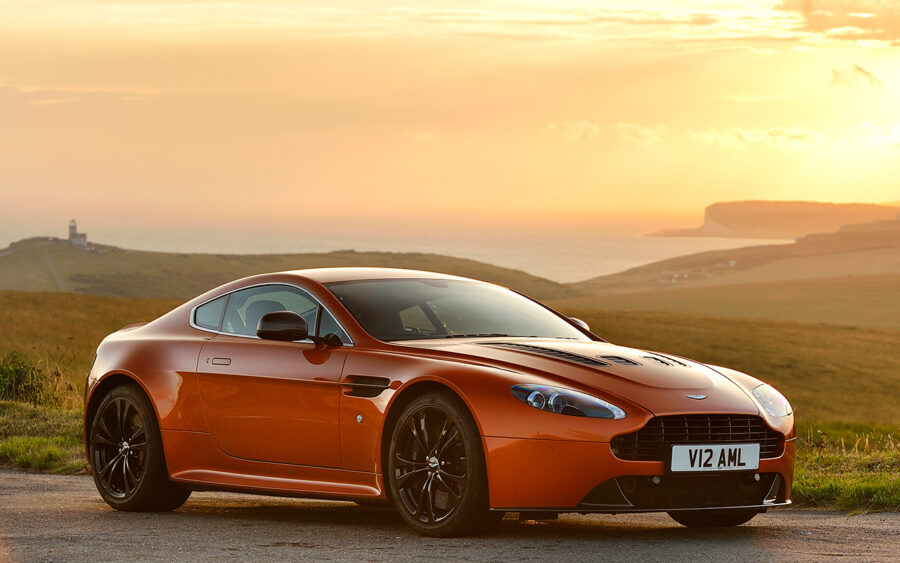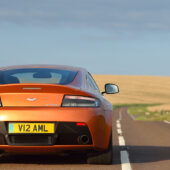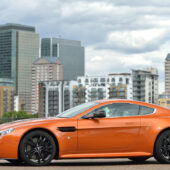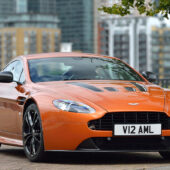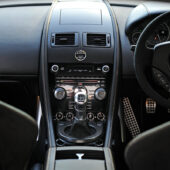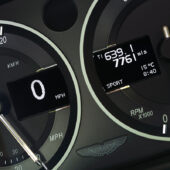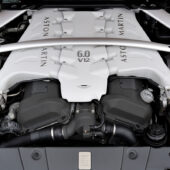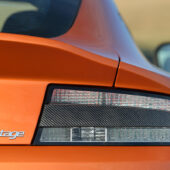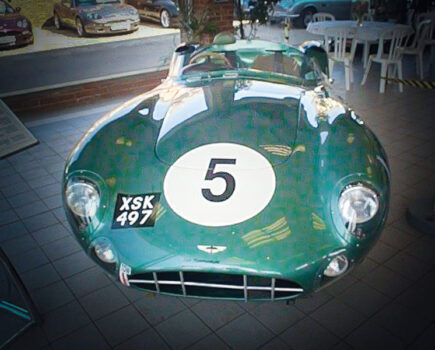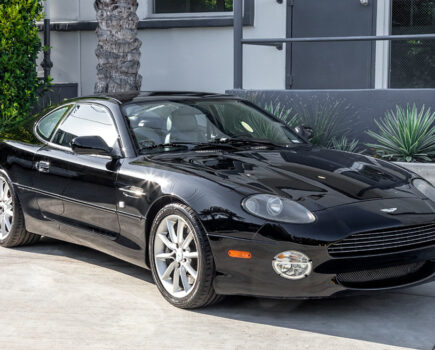The Aston Martin V12 Vantage saw the firm stick its biggest engine into its compact sports car – with electrifying results
Words: Kyle Fortune
A little under two years. That’s how long it took before someone at Aston Martin looked at the V8 Vantage and wondered whether one of the company’s V12s might fit under the bonnet. Proof of concept was the V12 Vantage RS in Feb ’08, a showcase from newly independent Aston Martin’s Special Vehicle Operations engineers, demonstrating that the company’s most powerful V12 would squeeze into its smallest body – albeit a tight fit. Revealed at an event at Aston Martin’s new Gaydon design HQ, the V12 Vantage RS was rolled out to the audience and the question asked whether they might like one. An emphatic yes, which is hardly surprising given the specification, with Aston Martin saying the 5.9-litre V12 should deliver around 600PS and a potential top speed of in excess of 200mph.
Development of what would be the production car continued apace, with not inconsiderable engineering challenges to make it possible. The crash structure needed altering, the deformable front to the V8 working because of the engine’s length – adding four more cylinders into the equation making that all a bit trickier. That and many other issues, covering everything from cooling to managing the additional weight all needed looking at, but Aston Martin has overcome all those hurdles, to create this, the 2009 V12 Vantage.
Staying remarkably true to the V12 Vantage RS’s look, the production V12 Vantage loses little over that concept, save for the RS badge and the concept’s pop-up rear spoiler. The 200mph goal wasn’t quite achieved, either, though you’re unlikely to be left wanting with when the V12’s hauling along at its 190mph maximum, it getting there quickly, passing the 62mph benchmark in just 4.2 seconds. Power from the 5.9-litre V12, incidentally, lifted from the DBS, is quoted at 517PS, again that slightly less than Aston Martin had initially promised. No matter though, because that Aston Martin was even willing, and has actually been able to build it is something to be celebrated. So too is the rest of the specification, Aston’s engineers commendably managing to keep the weight penalty over the V8 to around 50kg.
For that you can thank the use of carbon fibre in areas like the bonnet, diffuser, seats and Aston’s fitment of its carbon ceramic brakes as standard equipment. That lot helps offset the 100kg or so gain that those four extra cylinders add under the bonnet. Those additional pistons bring a useful 91PS benefit, and, more significantly, a 100Nm increase over the V8 for a 570Nm maximum torque output. Those peak outputs match that of the DBS where the V12 is lifted from, which, given the constraints of squeezing everything under the shorter bonnet of the Vantage is impressive indeed.
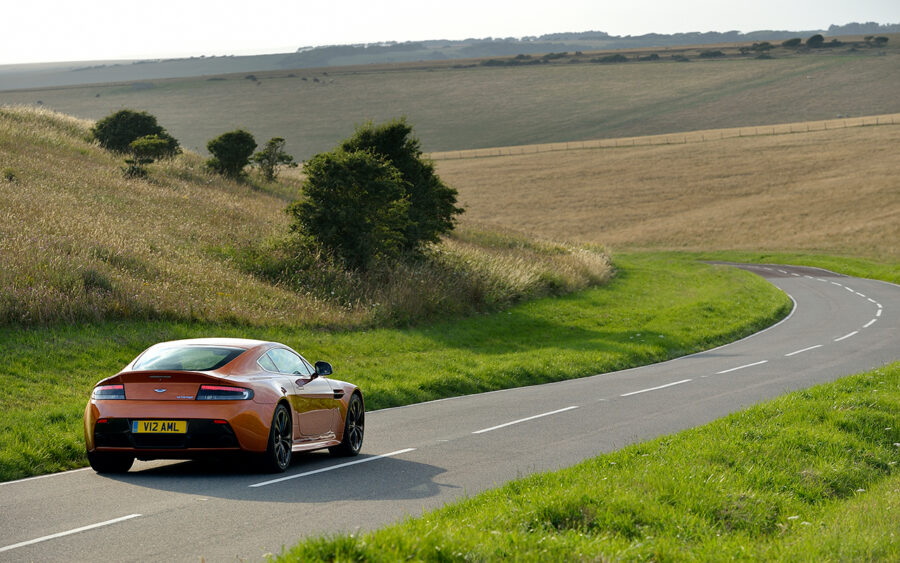
There have been some necessary concessions to do so, it’s so tight under the V12’s bonnet that heat management has been an issue, the simple solution being to vent out the top, something Aston Martin has made a feature of by finishing the vents in carbon fibre. It works, too, the two long lines of vents framing a pair of shorter ones adding a bit of brutal functionality to the Vantage’s face, as does the more aggressive splitter that pouts out front. Naturally, these cues are more apparent on lighter coloured cars where that black carbon weave creates a more obvious contrast, and fitting with the slightly skunkworks hotrod vibe that the V12 Vantage presents, and that is meant entirely in a good way.
The visual clues don’t stop there, but elsewhere they’re a bit more subtle. The V12 Vantage gaining wider side skirts, and a differing profile to the boot’s leading edge, all these borrowed from Aston’s racing department, these giving the V12 a more pugnacious look that’s in keeping with the more potent engine nestling under its punctured bonnet. Inside, the carbon fibre fixed back bucket seats embrace with a racer’s clutch, that alone upping the anticipation of what’s to come, while also increasing the connection and support. There’s an Alcantara-covered steering wheel to grasp, too, which feels good now, but how it’ll feel, and look, after years of use will be a different matter, it being likely a good number will be re-trimmed in leather in time.
What’s immediately apparent is the lack of paddles behind that wheel, Aston Martin’s most potent Vantage demanding that its driver orchestrate that V12 with three-pedals and a gearstick, with no option to simply flick over to drive and leave the transmission to it. That’s a part of the V12’s appeal, Aston Martin’s somewhat simplistic schtick of cramming as big an engine as it can into its smallest car rightfully only offered with a manual. This is, after all, meant to be a proper, involving and engaging driver’s car. A six-speeder, the gearstick’s topped with a knob that’s unusually chunky, it looking a bit out of place and more significantly being to the detriment of the shift quality itself.
If it were finished with something a bit smaller, neater and rounder it would work better, because there’s nothing wrong with the weighting and precision across the gate otherwise, that gearknob feeling unusual and obstructive to what in spite of the stylists’ best efforts inside, is a decent-shifting ‘box. The ratios are usefully short, too, allowing you the opportunity to explore the upper reaches of the engine’s rev range, and keeping you busy with that gearstick. Naturally, you can short or block shift and still make indecent progress, the V12’s linear surge allowing you to take liberties with the gearbox, but to so is to do yourself a disservice, because get that V12 singing in up above 5,000rpm and the sound is like little else, Aston’s V12 having really found its voice in this installation. That the V12 sounds magnificent isn’t really surprising, what is though is the ferocity of its performance in the mid-range. Without as much bulk as its bigger DB relations to move it really is scintillatingly quick.

The clutch’s weighting is nicely judged, while the brake pedal’s position and firmness creates a perfect platform with which to roll of it and blip the accelerator on downshifts. The engine’s eagerness to rev rewarding with quick response and a rousing, characterful note. There’s a brawniness to its performance that’s delightfully old-school in character, it demanding of you in a way that’s increasingly unusual in a world where paddle-shifters are becoming the norm. You’re aware of the big engine, but it doesn’t feel over-engined, or lacking in sophistication, it working as a whole, with the chassis not feeling like it’s having too much asked of it, even when you up the pace.
The steering weighting is good, though there’s not quite the delicacy of feel that you’ll get in the best of its rivals. That is perhaps a result of the big engine over its nose, the turn in too needing a little bit of management, doing so while the front tyres are still dealing with some brake load gives the nose a bit more authority, quelling the initial, slight, understeer that’s otherwise apparent. The brakes aid that to good effect, the pedal feel fantastic, and the bite being hugely confidence inspiring, all of which allows you to use them to help turn the V12’s nose that bit more quickly, allowing you to transition over to the accelerator to allow the V12 to fire out of the corner as you wind off lock and the rear wheels come into play. It’s an involving, immersive and enjoyable car to drive, and one where you, the driver, really can make a difference.
Press the Sport button and you’ll not only gain a slightly sharper throttle map, but the exhaust flaps open that little bit earlier to allow you to enjoy that V12’s wonderfully rousing aural performance, which just keeps getting better and better as the revs increase, it guttural but cultured, a blend of streetfighter with knowledge of Queensbury rules, that’s got the measure of even its Italian competition. Make no mistake, the V12 Vantage is a high point, an Aston Martin that mates the muscular performance of its more recent ancestors with a level of chassis compliance and competence that they couldn’t hope to muster. It’s exploitable and enjoyable, and underlines that there’s some real talent within Aston Martin’s engineering team, it feeling like a car that’s been built for enthusiasts, by enthusiasts, without the constraints of Aston’s old stewardship under Ford. If this, one of Aston Martin’s first proper Gaydon-era cars is a demonstration of what the company and its engineers is capable of, and prepared to build, when it’s left alone then it’s a very good sign of things to come.

